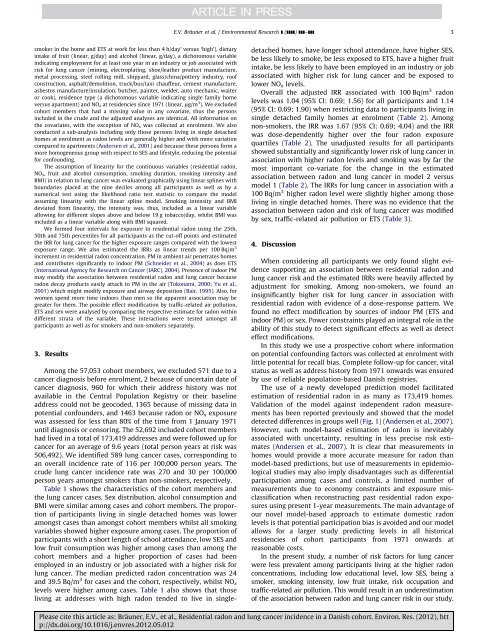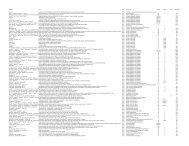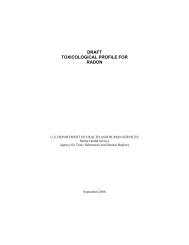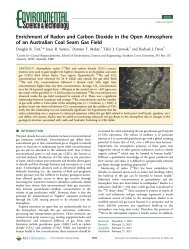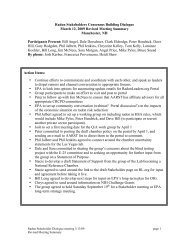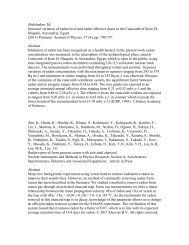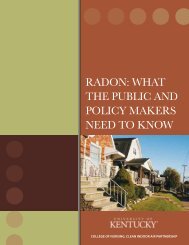Residential radon and lung cancer incidence in a Danish cohort - VBN
Residential radon and lung cancer incidence in a Danish cohort - VBN
Residential radon and lung cancer incidence in a Danish cohort - VBN
You also want an ePaper? Increase the reach of your titles
YUMPU automatically turns print PDFs into web optimized ePapers that Google loves.
E.V. Bräuner et al. / Environmental Research ] (]]]]) ]]]–]]] 3smoker <strong>in</strong> the home <strong>and</strong> ETS at work for less than 4 h/day’ versus ‘high’), dietary<strong>in</strong>take of fruit (l<strong>in</strong>ear, g/day) <strong>and</strong> alcohol (l<strong>in</strong>ear, g/day), a dichotomous variable<strong>in</strong>dicat<strong>in</strong>g employment for at least one year <strong>in</strong> an <strong>in</strong>dustry or job associated withrisk for <strong>lung</strong> <strong>cancer</strong> (m<strong>in</strong><strong>in</strong>g, electroplat<strong>in</strong>g, shoe/leather product manufacture,metal process<strong>in</strong>g, steel roll<strong>in</strong>g mill, shipyard, glass/ch<strong>in</strong>a/pottery <strong>in</strong>dustry, roofconstruction, asphalt/demolition, truck/bus/taxi chauffeur, cement manufacture,asbestos manufacture/<strong>in</strong>sulation, butcher, pa<strong>in</strong>ter, welder, auto mechanic, waiteror cook), residence type (a dichotomous variable <strong>in</strong>dicat<strong>in</strong>g s<strong>in</strong>gle family homeversus apartment) <strong>and</strong> NO x at residencies s<strong>in</strong>ce 1971 (l<strong>in</strong>ear, mg/m 3 ). We excluded<strong>cohort</strong> members that had a miss<strong>in</strong>g value <strong>in</strong> any covariate, thus the persons<strong>in</strong>cluded <strong>in</strong> the crude <strong>and</strong> the adjusted analyses are identical. All <strong>in</strong>formation onthe covariates, with the exception of NO x was collected at enrolment. We alsoconducted a sub-analysis <strong>in</strong>clud<strong>in</strong>g only those persons liv<strong>in</strong>g <strong>in</strong> s<strong>in</strong>gle detachedhomes at enrolment as <strong>radon</strong> levels are generally higher <strong>and</strong> with more variationcompared to apartments (Andersen et al., 2001) <strong>and</strong> because these persons form amore homogeneous group with respect to SES <strong>and</strong> lifestyle, reduc<strong>in</strong>g the potentialfor confound<strong>in</strong>g.The assumption of l<strong>in</strong>earity for the cont<strong>in</strong>uous variables (residential <strong>radon</strong>,NO x , fruit <strong>and</strong> alcohol consumption, smok<strong>in</strong>g duration, smok<strong>in</strong>g <strong>in</strong>tensity <strong>and</strong>BMI) <strong>in</strong> relation to <strong>lung</strong> <strong>cancer</strong> was evaluated graphically us<strong>in</strong>g l<strong>in</strong>ear spl<strong>in</strong>es withboundaries placed at the n<strong>in</strong>e deciles among all participants as well as by anumerical test us<strong>in</strong>g the likelihood ratio test statistic to compare the modelassum<strong>in</strong>g l<strong>in</strong>earity with the l<strong>in</strong>ear spl<strong>in</strong>e model. Smok<strong>in</strong>g <strong>in</strong>tensity <strong>and</strong> BMIdeviated from l<strong>in</strong>earity, the <strong>in</strong>tensity was, thus, <strong>in</strong>cluded as a l<strong>in</strong>ear variableallow<strong>in</strong>g for different slopes above <strong>and</strong> below 19 g tobacco/day, whilst BMI was<strong>in</strong>cluded as a l<strong>in</strong>ear variable along with BMI squared.We formed four <strong>in</strong>tervals for exposure to residential <strong>radon</strong> us<strong>in</strong>g the 25th,50th <strong>and</strong> 75th percentiles for all participants as the cut-off po<strong>in</strong>ts <strong>and</strong> estimatedthe IRR for <strong>lung</strong> <strong>cancer</strong> for the higher exposure ranges compared with the lowestexposure range. We also estimated the IRRs as l<strong>in</strong>ear trends per 100 Bq/m 3<strong>in</strong>crement <strong>in</strong> residential <strong>radon</strong> concentration. PM <strong>in</strong> ambient air penetrates homes<strong>and</strong> contributes significantly to <strong>in</strong>door PM (Schneider et al., 2004) as does ETS(International Agency for Research on Cancer (IARC), 2004). Presence of <strong>in</strong>door PMmay modify the association between residential <strong>radon</strong> <strong>and</strong> <strong>lung</strong> <strong>cancer</strong> because<strong>radon</strong> decay products easily attach to PM <strong>in</strong> the air (Tokonami, 2000; Yu et al.,2001) which might modify exposure <strong>and</strong> airway deposition (Bair, 1995). Also, forwomen spend more time <strong>in</strong>doors than men so the apparent association may begreater for them. The possible effect modification by traffic-related air pollution,ETS <strong>and</strong> sex were analysed by compar<strong>in</strong>g the respective estimate for <strong>radon</strong> with<strong>in</strong>different strata of the variable. These <strong>in</strong>teractions were tested amongst allparticipants as well as for smokers <strong>and</strong> non-smokers separately.3. ResultsAmong the 57,053 <strong>cohort</strong> members, we excluded 571 due to a<strong>cancer</strong> diagnosis before enrolment, 2 because of uncerta<strong>in</strong> date of<strong>cancer</strong> diagnosis, 960 for which their address history was notavailable <strong>in</strong> the Central Population Registry or their basel<strong>in</strong>eaddress could not be geocoded, 1365 because of miss<strong>in</strong>g data <strong>in</strong>potential confounders, <strong>and</strong> 1463 because <strong>radon</strong> or NO x exposurewas assessed for less than 80% of the time from 1 January 1971until diagnosis or censor<strong>in</strong>g. The 52,692 <strong>in</strong>cluded <strong>cohort</strong> membershad lived <strong>in</strong> a total of 173,419 addresses <strong>and</strong> were followed up for<strong>cancer</strong> for an average of 9.6 years (total person years at risk was506,492). We identified 589 <strong>lung</strong> <strong>cancer</strong> cases, correspond<strong>in</strong>g toan overall <strong><strong>in</strong>cidence</strong> rate of 116 per 100,000 person years. Thecrude <strong>lung</strong> <strong>cancer</strong> <strong><strong>in</strong>cidence</strong> rate was 270 <strong>and</strong> 30 per 100,000person years amongst smokers than non-smokers, respectively.Table 1 shows the characteristics of the <strong>cohort</strong> members <strong>and</strong>the <strong>lung</strong> <strong>cancer</strong> cases. Sex distribution, alcohol consumption <strong>and</strong>BMI were similar among cases <strong>and</strong> <strong>cohort</strong> members. The proportionof participants liv<strong>in</strong>g <strong>in</strong> s<strong>in</strong>gle detached homes was loweramongst cases than amongst <strong>cohort</strong> members whilst all smok<strong>in</strong>gvariables showed higher exposure among cases. The proportion ofparticipants with a short length of school attendance, low SES <strong>and</strong>low fruit consumption was higher among cases than among the<strong>cohort</strong> members <strong>and</strong> a higher proportion of cases had beenemployed <strong>in</strong> an <strong>in</strong>dustry or job associated with a higher risk for<strong>lung</strong> <strong>cancer</strong>. The median predicted <strong>radon</strong> concentration was 24<strong>and</strong> 39.5 Bq/m 3 for cases <strong>and</strong> the <strong>cohort</strong>, respectively, whilst NO xlevels were higher among cases. Table 1 also shows that thoseliv<strong>in</strong>g at addresses with high <strong>radon</strong> tended to live <strong>in</strong> s<strong>in</strong>gledetachedhomes, have longer school attendance, have higher SES,be less likely to smoke, be less exposed to ETS, have a higher fruit<strong>in</strong>take, be less likely to have been employed <strong>in</strong> an <strong>in</strong>dustry or jobassociated with higher risk for <strong>lung</strong> <strong>cancer</strong> <strong>and</strong> be exposed tolower NO x levels.Overall the adjusted IRR associated with 100 Bq/m 3 <strong>radon</strong>levels was 1.04 (95% CI: 0.69; 1.56) for all participants <strong>and</strong> 1.14(95% CI: 0.69; 1.90) when restrict<strong>in</strong>g data to participants liv<strong>in</strong>g <strong>in</strong>s<strong>in</strong>gle detached family homes at enrolment (Table 2). Amongnon-smokers, the IRR was 1.67 (95% CI: 0.69; 4.04) <strong>and</strong> the IRRwas dose-dependently higher over the four <strong>radon</strong> exposurequartiles (Table 2). The unadjusted results for all participantsshowed substantially <strong>and</strong> significantly lower risk of <strong>lung</strong> <strong>cancer</strong> <strong>in</strong>association with higher <strong>radon</strong> levels <strong>and</strong> smok<strong>in</strong>g was by far themost important co-variate for the change <strong>in</strong> the estimatedassociation between <strong>radon</strong> <strong>and</strong> <strong>lung</strong> <strong>cancer</strong> <strong>in</strong> model 2 versusmodel 1 (Table 2). The IRRs for <strong>lung</strong> <strong>cancer</strong> <strong>in</strong> association with a100 Bq/m 3 higher <strong>radon</strong> level were slightly higher among thoseliv<strong>in</strong>g <strong>in</strong> s<strong>in</strong>gle detached homes. There was no evidence that theassociation between <strong>radon</strong> <strong>and</strong> risk of <strong>lung</strong> <strong>cancer</strong> was modifiedby sex, traffic-related air pollution or ETS (Table 3).4. DiscussionWhen consider<strong>in</strong>g all participants we only found slight evidencesupport<strong>in</strong>g an association between residential <strong>radon</strong> <strong>and</strong><strong>lung</strong> <strong>cancer</strong> risk <strong>and</strong> the estimated IRRs were heavily affected byadjustment for smok<strong>in</strong>g. Among non-smokers, we found an<strong>in</strong>significantly higher risk for <strong>lung</strong> <strong>cancer</strong> <strong>in</strong> association withresidential <strong>radon</strong> with evidence of a dose-response pattern. Wefound no effect modification by sources of <strong>in</strong>door PM (ETS <strong>and</strong><strong>in</strong>door PM) or sex. Power constra<strong>in</strong>ts played an <strong>in</strong>tegral role <strong>in</strong> theability of this study to detect significant effects as well as detecteffect modifications.In this study we use a prospective <strong>cohort</strong> where <strong>in</strong>formationon potential confound<strong>in</strong>g factors was collected at enrolment withlittle potential for recall bias. Complete follow-up for <strong>cancer</strong>, vitalstatus as well as address history from 1971 onwards was ensuredby use of reliable population-based <strong>Danish</strong> registries.The use of a newly developed prediction model facilitatedestimation of residential <strong>radon</strong> <strong>in</strong> as many as 173,419 homes.Validation of the model aga<strong>in</strong>st <strong>in</strong>dependent <strong>radon</strong> measurementshas been reported previously <strong>and</strong> showed that the modeldetected differences <strong>in</strong> groups well (Fig. 1) (Andersen et al., 2007).However, such model-based estimation of <strong>radon</strong> is <strong>in</strong>evitablyassociated with uncerta<strong>in</strong>ty, result<strong>in</strong>g <strong>in</strong> less precise risk estimates(Andersen et al., 2007). It is clear that measurements <strong>in</strong>homes would provide a more accurate measure for <strong>radon</strong> thanmodel-based predictions, but use of measurements <strong>in</strong> epidemiologicalstudies may also imply disadvantages such as differentialparticipation among cases <strong>and</strong> controls, a limited number ofmeasurements due to economy constra<strong>in</strong>ts <strong>and</strong> exposure misclassificationwhen reconstruct<strong>in</strong>g past residential <strong>radon</strong> exposuresus<strong>in</strong>g present 1-year measurements. The ma<strong>in</strong> advantage ofour novel model-based approach to estimate domestic <strong>radon</strong>levels is that potential participation bias is avoided <strong>and</strong> our modelallows for a larger study predict<strong>in</strong>g levels <strong>in</strong> all historicalresidencies of <strong>cohort</strong> participants from 1971 onwards atreasonable costs.In the present study, a number of risk factors for <strong>lung</strong> <strong>cancer</strong>were less prevalent among participants liv<strong>in</strong>g at the higher <strong>radon</strong>concentrations, <strong>in</strong>clud<strong>in</strong>g low educational level, low SES, be<strong>in</strong>g asmoker, smok<strong>in</strong>g <strong>in</strong>tensity, low fruit <strong>in</strong>take, risk occupation <strong>and</strong>traffic-related air pollution. This would result <strong>in</strong> an underestimationof the association between <strong>radon</strong> <strong>and</strong> <strong>lung</strong> <strong>cancer</strong> risk <strong>in</strong> our study.Please cite this article as: Bräuner, E.V., et al., <strong>Residential</strong> <strong>radon</strong> <strong>and</strong> <strong>lung</strong> <strong>cancer</strong> <strong><strong>in</strong>cidence</strong> <strong>in</strong> a <strong>Danish</strong> <strong>cohort</strong>. Environ. Res. (2012), http://dx.doi.org/10.1016/j.envres.2012.05.012


